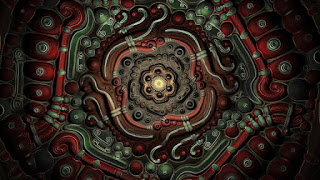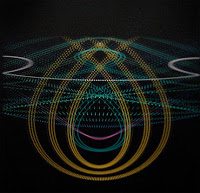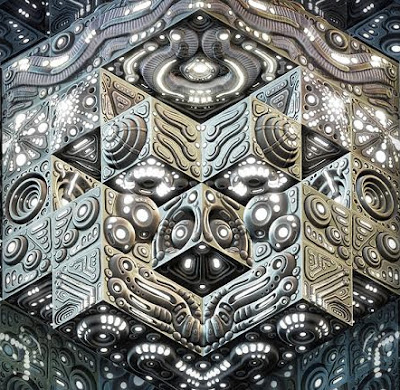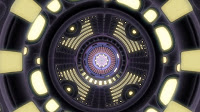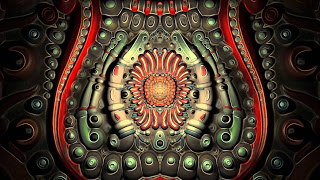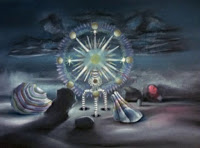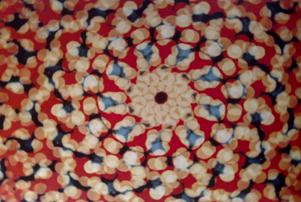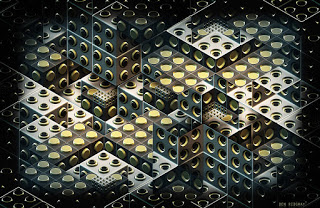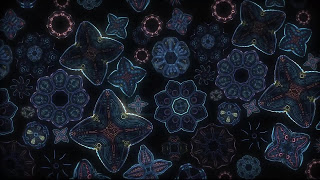Oddball Films Media
•
Jan 17, 2016
Oddball Films welcomes experimental animator, artist and professor Ben Ridgway to our Cinema Soiree Series, a monthly event featuring visiting authors, filmmakers and curators presenting and sharing cinema insights and films. Ridgway's mind-blowing abstract animations feature hypnotic and futuristic geometric forms that bring to mind the interior of an alien spaceship or the otherworldly beauty of an Ernst Haeckl engraving. Ridgway has been working on his sublime and hallucinatory experimental films since 1992 and his work has been featured in film festivals around the world. His “abstract animations investigate the metaphysical features of reality. They are designed to stimulate archetypal associations and invite the viewer to make personal connections to the visual and auditory experience without any reliance on narrative or spoken language. The focus is using newly available software applications in unconventional ways to generate innovative approaches to creating avant-garde films." Ridgway will be discussing his innovative approach to computer imagery as well as some of his influences in experimental animation and screening a selection of his metamorphic metaphysical work including Cosmic Flower Unfolding (2013), Inner Space Artifacts (2014), Tribocycle (2013), and Cellular Circuitry (2011) To foreground his work, the archive will be screening transcendent experimental works on 16mm film including John Whitney's Arabesque (1975), James Whitney's Lapis (1966), Norman McLaren's A Phantasy (1952) and Blinkity Blank (1955) and Ishu Patel's Perspectrum (1974).
Date: Thursday, January 21st, 2016 at 8:00pm
Venue: Oddball Films, 275 Capp Street San Francisco
Featuring:
Inner Space Artifacts (Color, 2014)
“Inner Space Artifacts” is a depiction of artifacts from inner space transformed into moving digital sculptures.
Tribocycle (Color, 2013)
“Tribocycle” is an abstract animation that explores the concept of infinity and time through a continuously evolving set of rings. The film is designed for large scale projections and installations.
Cosmic Flower Unfolding (Color, 2013)
“Cosmic Flower Unfolding” is a constant flow of emerging and dissolving oceanic, futuristic, and mandala forms. It is a tribute to abstraction, its connection to the inner space we inhabit and how it can be externalized.
Cellular Circuitry (Color, 2011)
“Cellular Circuitry” is a stream of digital sculptures and soundscapes that dynamically transmute between organic and circuit-like motifs. It is a reflection of artificial versus natural systems animated in such a way to show that they are intimately connected to one another.
16mm selections from the archive:
Blinkity Blank (color, 1955, 6 min.)
An eye-popping experiment in the use of intermittent animation and spasmodic imagery. the brilliant animator Norman McLaren plays with the laws relating to persistence of vision and after-image on the retina of the eye. He engraves pictures on blank film, with percussive effects added in the same way.
A Phantasy (color, 1952, 8 min.)
Cut-out animation by Norman McLaren, and music for saxophones and synthetic sound by Maurice Blackburn. In a dream-like, meditative and surreal landscape drawn in pastel, inanimate objects come to life to disport themselves in grave dances and playful ritual.
Arabesque (Color, 1975, John Whitney) Early abstract computer-generated film by pioneer John Whitney- shimmering lines and waves of oscillating color dance to the music of Eastern rhythms and evolve from randomness to patterns inspired by 8th century Persian designs. Inspired by his 1974 visit to the city of Isfahan in Iran, Whitney found a relation between the formal and visual tradition of Islamic art and architecture and his own computer graphic study. Whitney famously collaborated with Saul Bass on the title sequence to Hitchcock’s Vertigo.
Lapis (Color, 1963–1966, James Whitney)
James Whitney’s Lapis (1966) is a classic work of abstract cinema, a 10-minute animation created with primitive computer equipment over a three-year period. In this piece, the smaller circles oscillating in and out in an array of colors resemble a kaleidoscope and are accompanied by Indian sitar music. The patterns gradually have a hypnotic, trance-inducing effect. The auditory and visual senses clearly correlate in this work and deliver a wonderful example of the phenomenon of synaesthesia.
James Whitney is regarded as one of the great masters of visual music and he and his brother John (see Arabesque above) were pioneers in the use of computer technology in cinema.
Perspectrum (Color, 1974)
A film without words produced for the National Film Board of Canada. This animated short consists of simple geometric forms, as thin and flat as playing cards, but so arranged that a sense of perspective is conveyed. The effect is kaleidoscopic, but much more active, forming and re-forming constantly to the music. The koto, a thirteen-stringed Japanese instrument, is played by plucking the strings; the sound has a tinkling effect, synched to the glasslike shapes of the moving designs. Directed by famed Indian animator Ishu Patel with music by Michio Miyagi.
Ben is currently an Assistant Professor at San Francisco State University in San Francisco, California, USA. He has 15 years of professional experience as both a 3D artist in the video game industry and as a Professor. While in the games industry he helped to create games for Nintendo, Sony, and Microsoft console systems. Ben has been making experimental animations since 1992.
“My abstract animations investigate the metaphysical features of reality. They are designed to stimulate archetypal associations and invite the viewer to make personal connections to the visual and auditory experience without any reliance on narrative or spoken language.
My art is intimately connected to the exploration of new technologies used for 3D computer graphics and animation. My focus is using newly available software applications in unconventional ways to generate innovative approaches to creating avant-garde films. The driving vision behind my work is fueled by drawings I make using traditional media. These drawings are created spontaneously using a vocabulary of structural forms that I have developed over time that can be arranged and interchanged in a multitude of different ways. My drawings are mostly abstract but sometimes can cross over into figurative designs fused with abstract forms. The musical compositions in my work are inspired by the use of both analogue and digital sources. Most of the time the musical arrangements I design straddle the line between atmospheric noise and music. My goal is to use sound in a way that creates an auditory parallel to the visual experience. Lighting, color, visual symbols and qualities of motion all inform the music I create. Both music and motion play equal roles in my film making process and a deep knowledge of both of these disciplines have allowed me to create unique works of art that few people can create single-handedly.
My work is abstract by nature and uses non narrative film making techniques. The undercurrents of my work point to themes centered on time, cycles, the concept of infinity, and the similarities between artificial and natural systems. In a world where technology and artificial systems are becoming more prevalent my films are a reminder that they are both a product of nature. The processes I develop to create my work are equally important as the final product. I strive to find new and innovative methods for creating sophisticated animations while retaining the ability to use intuition and spontaneity throughout the creative process. My films do not contain dialogue or written language of any sort. This allows my films to be enjoyed and interpreted by anyone regardless of their native language."
